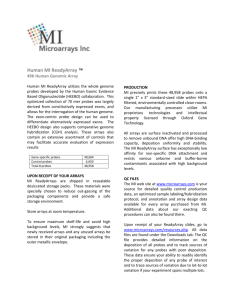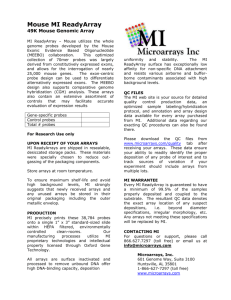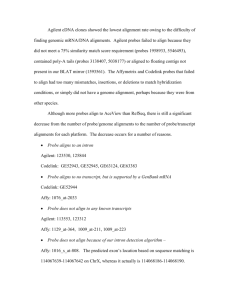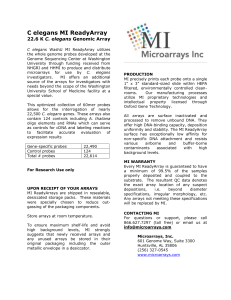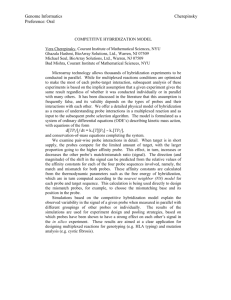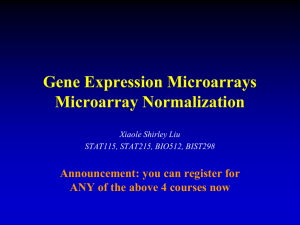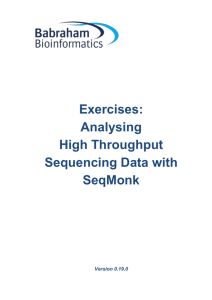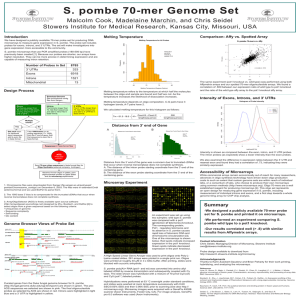MM1100_Mouse_MI_ReadyArray_details
advertisement
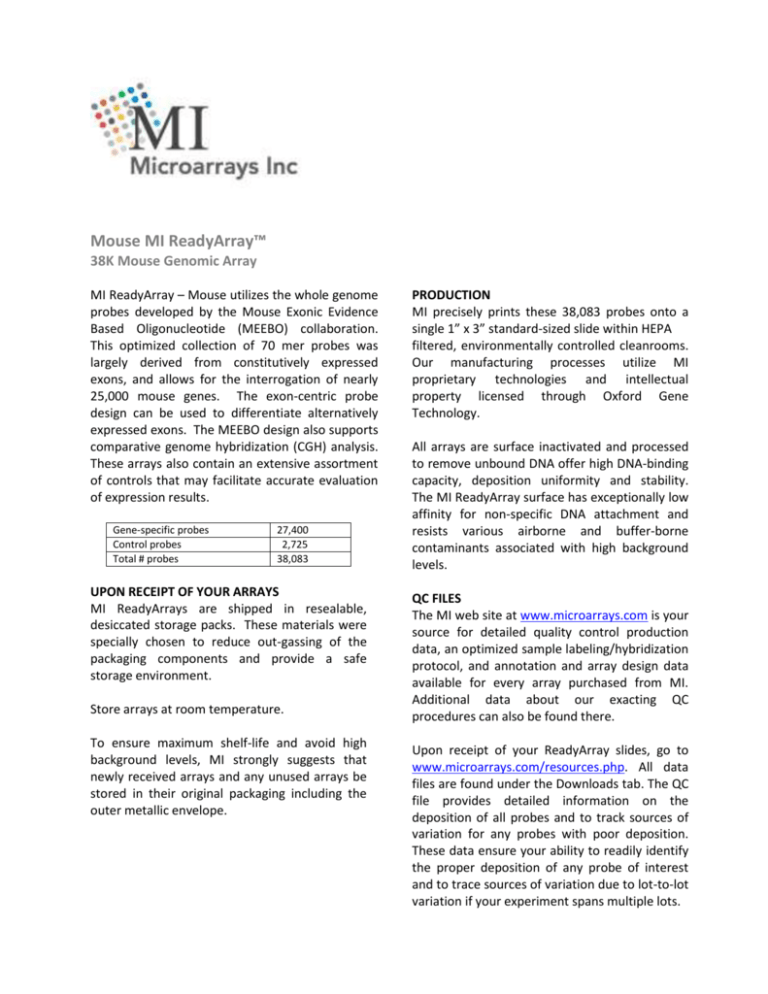
Mouse MI ReadyArray™ 38K Mouse Genomic Array MI ReadyArray – Mouse utilizes the whole genome probes developed by the Mouse Exonic Evidence Based Oligonucleotide (MEEBO) collaboration. This optimized collection of 70 mer probes was largely derived from constitutively expressed exons, and allows for the interrogation of nearly 25,000 mouse genes. The exon-centric probe design can be used to differentiate alternatively expressed exons. The MEEBO design also supports comparative genome hybridization (CGH) analysis. These arrays also contain an extensive assortment of controls that may facilitate accurate evaluation of expression results. Gene-specific probes Control probes Total # probes 27,400 2,725 38,083 UPON RECEIPT OF YOUR ARRAYS MI ReadyArrays are shipped in resealable, desiccated storage packs. These materials were specially chosen to reduce out-gassing of the packaging components and provide a safe storage environment. Store arrays at room temperature. To ensure maximum shelf-life and avoid high background levels, MI strongly suggests that newly received arrays and any unused arrays be stored in their original packaging including the outer metallic envelope. PRODUCTION MI precisely prints these 38,083 probes onto a single 1” x 3” standard-sized slide within HEPA filtered, environmentally controlled cleanrooms. Our manufacturing processes utilize MI proprietary technologies and intellectual property licensed through Oxford Gene Technology. All arrays are surface inactivated and processed to remove unbound DNA offer high DNA-binding capacity, deposition uniformity and stability. The MI ReadyArray surface has exceptionally low affinity for non-specific DNA attachment and resists various airborne and buffer-borne contaminants associated with high background levels. QC FILES The MI web site at www.microarrays.com is your source for detailed quality control production data, an optimized sample labeling/hybridization protocol, and annotation and array design data available for every array purchased from MI. Additional data about our exacting QC procedures can also be found there. Upon receipt of your ReadyArray slides, go to www.microarrays.com/resources.php. All data files are found under the Downloads tab. The QC file provides detailed information on the deposition of all probes and to track sources of variation for any probes with poor deposition. These data ensure your ability to readily identify the proper deposition of any probe of interest and to trace sources of variation due to lot-to-lot variation if your experiment spans multiple lots. MEEBO PROBE DATA DESIGN APPROACH Sequence Selection and Probe Design Briefly, the pipeline for sequence selection and probe design included three steps: 1. Collect and curate exon sequences, supplemented as needed with transcript sequences. 2. Design and select the candidate 70mer probes for exon or transcript sequences. ArrayOligoSelector was used to generate a list of all candidate probes for each sequence. The probe list was filtered using a number of parameters (including probe uniqueness, self-binding score, complexity score, GC content) to narrow and rank the list of candidate probes. 3. Optimal probes were chosen from the candidate list. Probes had binding energies >-35 kcal/mol for other probe sequences, were less than 1,000 bases from the 3’ end of the transcript and would be present in all processed exons/transcripts. When these three criteria could not be met, more than one probe was selected to represent the exon or transcript sequence. MI WARRANTEE Every MI ReadyArray is guaranteed to have a minimum of 99.5% of the samples properly deposited and coupled to the substrate. The resultant QC data denotes the exact array location of any suspect depositions, i.e. beyond diameter specifications, irregular morphology, etc. CONTACTING MI For questions or support, please call 256-3270544 or email us at info@microarrays.com Microarrays, Inc. 601 Genome Way, Suite 3100 Huntsville, AL 35806 1-256-327-0544 www.microarrays.com info@microarrays.com ANNOTATION Detailed information is provided in the downloadable file MM1100_Mouse_MI_ReadyArray_genelist.xls file found on the MI website at www.microarrays.com/resources.php. The file data include: • Probe_Name: Contains the oligo name. The following codes can assist with interpreting the oligo name: - Rockefeller MouSDB3 constitutive exons / islands (oligo names start with ‘scl’) - LocusLink constitutive exons / islands (oligo names start with ‘scl0’) - mRNA derived 70mers which may span intron/exon boundaries (oligo names start with ‘scl00’) - A collection of alternative spliced / skipped exons generated through extensive curation of 5 published datasets by Max Diehn, Ash Alizadeh, Jean Yang, and Catherine Foo (oligo names start with ‘scl000’) - Syntenic orthologs of human loci exhibiting cis-antisense transcription based on Yelin et al Nature Biotech 2003. (oligo names start with ‘scl0000’) ADDITIONAL PROBE DETAILS NUMBER OF PROBES PROBE TYPE PROBE FUNCTION 13 Mitochondrial probes Designed to recognize mouse mitochondrion derived DNA sequences 37 Transgenic / Vector Designed to recognize elements commonly used for transgenic constructs (e.g. GFP, YFP). 358 Viral Probes Designed to recognize mouse viral pathogen sequences 1,152 Positive Controls Designed to recognize a small subset of mouse exons or transcripts 414 Negative Controls 317 empty wells and 97 random sequences are positioned throughout the set to assist in determining background. Spiking Controls Recognize non-mouse sequences that can be spiked into RNA samples. 1,916

